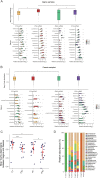Perinatal Antibiotic Exposure Affects the Transmission between Maternal and Neonatal Microbiota and Is Associated with Early-Onset Sepsis
- PMID: 32075882
- PMCID: PMC7031618
- DOI: 10.1128/mSphere.00984-19
Perinatal Antibiotic Exposure Affects the Transmission between Maternal and Neonatal Microbiota and Is Associated with Early-Onset Sepsis
Abstract
Intrapartum antibiotic prophylaxis reduces the risk of infection to a mother and neonate, but antibiotic-mediated maternal and neonatal microbiota dysbiosis increases other health risks to newborn infants. We studied the impact of perinatal antibiotic prophylaxis on the microbiota in mothers and newborns with full-term or preterm delivery. Ninety-eight pregnant women and their neonates were divided into the following four groups: full term without antibiotic exposure (FT), full term with antibiotic exposure (FTA), preterm without antibiotic exposure (PT), and preterm with antibiotic exposure (PTA). Bacterial composition was analyzed by sequencing the 16S rRNA gene from maternal vaginal swabs (V) and neonatal meconium (F). The results showed that in maternal vaginal and neonatal meconium microbiota, FT and PT groups had a higher load of Lactobacillus spp. than did the FTA and PTA groups. In addition, whether in the mother or newborn, the dissimilarity in microbiota between FT and PT was the lowest compared to that between other groups. Compared to the FT and PT groups, the dissimilarity in microbial structures between the vagina and meconium decreased in the FTA and PTA groups. The health outcome of infants reveals an association between early-onset sepsis and antibiotic-mediated microbiota dysbiosis. In conclusion, perinatal antibiotic exposure is related to the establishment of gut microbiota and health risks in newborns. Promoting the rational usage of antibiotics with pregnant women will improve neonatal health.IMPORTANCE Perinatal antibiotic prophylaxis is an effective method for preventing group B Streptococcus (GBS) infection in newborns. Antibiotic exposure unbalances women's vaginal microbiota, which is associated with the establishment of the newborn gut microbiota. However, the influence of perinatal antibiotic exposure on neonatal gut microbiota colonization and health outcomes remains unclear. In this study, we found that perinatal antibiotic exposure induced microbiota dysbiosis in a woman's vagina and the neonatal gut, and we highlight a significant decrease in the abundance of Lactobacillus spp. The influence of antibiotic use on the microbiota was greater than that from gestational age. Additionally, full-term newborns without antibiotic exposure had no evidence of early-onset sepsis, whereas in full-term or preterm newborns with antibiotic exposure before birth, at least one infant was diagnosed with early-onset sepsis. These results suggest an association between perinatal antibiotic exposure and microbial dysbiosis in maternal vaginal and neonatal gut environments, which may be related to the occurrence of early-onset sepsis.
Keywords: early-onset sepsis; maternal vaginal microbiota; meconium microbiota; perinatal antibiotic exposure; perinatal antibiotic treatment.
Copyright © 2020 Zhou et al.
Figures

References
MeSH terms
Substances
LinkOut - more resources
Full Text Sources
Medical
Miscellaneous
